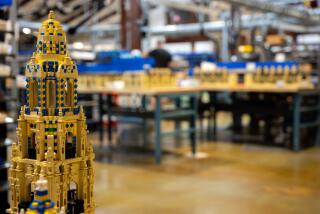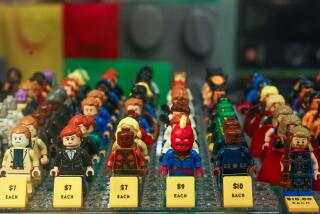Favorite Toys of Years Gone By in Demand for Profit, Nostalgia
- Share via
Memories of toys from childhoods long past come surging to the fore this time of year: the train set that circled the Christmas tree in 1959, the shiny silver cap gun that transformed a runny-nosed kid into Hopalong Cassidy, or the toy soldiers that once stood guard against dirt-clod assaults.
But memories are all that most adults have of these toys, unless they happen to belong to the growing ranks of those who collect them. Toys are in demand--whether they are dolls, radio premiums, trains, airplanes or cap guns--partly because of nostalgia and partly for their collectible value.
A recent edition of Antique Toy World magazine contained 10 pages of classified ads offering to sell or buy toys, and listed more than 140 dates for toy shows from such places as Kansas, New Jersey and Texas to Pomona and West Hollywood.
Bill Hamburg, 50, is a gun collector.
When guests first see his toy gun collection, which fills the gun room in his Woodland Hills home, “most people discover they still have that little child inside them,” said Hamburg. “Then they try and find their old cap gun from their childhood.”
Hamburg, a sales manager for the Southern California Gas Co., became interested in cap guns while rummaging around a Washington state antique store on vacation seven years ago with his wife, Loretta. He spotted a Hubley 50-shot Texan six-shooter, a duplicate of the first cap gun he owned as a child. It was in excellent shape, but he didn’t like the $35 price tag, so he reluctantly passed.
Penny Pistol
The chance cap gun encounter started him collecting, first the cap guns he remembered as a child in the late 1940s, then others. Today, his earliest examples include an 1870 double-hammer pistol and a cast-iron 1887 Penny Pistol, so named because of it cost 1 cent.
While Hamburg’s collection has all sizes and shapes of cap guns, including models embossed with such names as Gene Autry, Roy Rogers, the Lone Ranger and Hopalong Cassidy, he said the most unusual are the animated ones made as novelties, not for children.
One such cap gun, from the 1880s, has a cast-iron human figure about 1 1/2 inches tall standing on the barrel. The gun goes off when the hammer strikes a cap that sits on the man’s head.
Two cap guns in his collection mean more to Hamburg than the nearly 300 others.
The first is a cap pistol his father played with as a young boy, and the other, one of a dozen cap guns neatly displayed on a small glass table, is the Hubley Texan he first spotted in Washington.
“I just had this urge to own it,” he said. He drove back to the store a year later, without calling first, still hoping it would be there.
Roger Steiner, 45, owns three dozen trucks, specifically Smith-Miller toy trucks made in the 1940s and ‘50s from die-cast aluminum. The two-foot-long vehicles were patterned after then-current prototypes, including moving vans, tank trucks, army vehicles and lumber trucks.
“A friend gave me one in so-so shape about eight years ago,” said the West Valley resident, “and it reminded me of one I had when I was a kid. Restoring it rekindled a lot of old memories.”
While complete models in good shape are becoming scarce, Steiner said, replacement parts have been easy to find since Valley resident Fred Thompson purchased in 1978 the stored remains of the Smith-Miller company, which went out of business in the mid-1950s. Besides replacement parts, Thompson also has been offering new truck models.
Steiner tries to buy the trucks as cheaply as possible, knowing it will take about 40 hours of filing, bending, cleaning and undoing decades of disuse to return them to displayable shape.
Steiner is constantly looking for more trucks to add to the collection that is displayed on boards mounted on the wall of his bedroom. Browsing through a hobby magazine or wandering around toy shows, he keeps his eye out for trucks, especially some of the older Chevy-style designs made in the late 1940s. “They’re getting hard to find in any shape,” he said, “especially now that people are realizing their value.”
Louis Steinberg’s fond childhood memories rekindled a desire to collect three-inch-tall, pot-metal, dime-store soldiers.
“They were made as toys you plunked a nickel or dime down at the store for,” said the 59-year-old Chatsworth resident, “so they were meant to be played with. As children, we bombed, threw rocks and aimed marbles at them.”
The young Steinberg also made his own soldiers by pouring melted tire-balancing weights and foil from Lucky Strike cigarette packs into molds borrowed from a friend.
But when Steinberg grew up, he left them behind, until 20 years ago when he came across a Glendale garage sale that had, among other items, pot-metal, dime-store soldiers.
“I had forgotten all about them,” he said. “They were exactly what I remembered, and in excellent condition.” He purchased all 15 soldiers for less than 50 cents apiece. Today, Steinberg can’t say how many soldiers are in his collection, except that he has “uncounted thousands.”
Although there were dozens of small manufacturers, two, Barclay and Manoil, were the largest, Steinberg said. While all the figures were known as “soldiers,” the various companies sold non-military figures as well, including doctors, nurses and lumberjacks. His rarest piece is a Barclay deep-sea diver holding an ax that he estimates is worth $300. Refurbished soldiers in good condition go for about $10.
Neatly Stacked Boxes
Someday, he hopes to display his soldiers in dioramas; a few are in custom cases. Most are stored in neatly stacked cardboard boxes in closets throughout his home.
“It’s like any other collectible,” he said. “Hopefully, one day I’ll have the joy of having them displayed.”
North Hollywood dentist Dr. Hillel (Hilly) Lazarus, 54, regularly visits toy train conventions to add to his tin-plate train collection.
Owning more than 200 locomotives and about 1,000 freight and passenger cars, Lazarus admits that he wasn’t too careful with his first tin-plate train, which “bit the dust in the sandbox,” when he was 3 years old. He can produce a picture of himself in the sandbox with the train to prove it.
Lazarus prefers to collect the lesser-known pre-World War II American Flyer O gauge track, which was manufactured from 1907-42, to the more popularly known Lionel tin-plated iron and steel track.
Lazarus collects not for the investment value but for his love of trains.
“The nostalgic binge of the last 10 years has changed people’s perceptions,” he said. “Now instead of being an interesting hobby, some people just see dollar signs.”
Hoping to eventually display his trains--everything is currently in storage--Lazarus is active in toy train associations and can usually be found attending area swap meets.
When people learn of his hobby, Lazarus said, they usually comment, “I had one just like that when I was a kid,” That’s easier to take than the second most-heard line: “We used to have one like that, but we threw it away.”
Burbank writer Jim Harmon, 56, has been a collector all his life. Some of his 600-piece radio premium collection contains items he sent away for as kid growing up in Mt. Carmel, Ill.
“Basically it started with Little Orphan Annie in 1931. ‘Send me an Ovaltine seal and a dime, and I’ll send you a shake-up mug for your Ovaltine,’ ” he said, recalling the premium advertisement.
The popularity of radio premiums rose and fell with radio dramas, and the last of them, which evaporated with the beginning of television, were offered in the late 1950s.
“It was a form of a ratings service,” said Harmon, explaining why sponsors offered premiums. “There was no profit, and the cost of the premium had to stay in the advertising budget. They just wanted to run a survey of how many kids were listening.”
Whatever the sponsors’ motivations, it was a delight to kids, said Harmon, with almost every show at one time or another offering everything from drinking mugs to dioramas, rings, telescopes and pedometers.
Some of his most prized pieces are the premiums that flopped.
When “Jack Armstrong, the All-American Boy” offered a telescope, millions were mailed out, Harmon said. But when the same sponsor offered a gardenia bracelet for girls that would glow in the dark, it was a bomb. Only about 200 were requested; Harmon has copies of the cereal company’s records to prove it. The premium was withdrawn after two days.
Harmon figures the most popular radio premium giveaways were from the most popular show, cowboy Tom Mix and his horse, Tony, on “The Tom Mix Show,” sponsored by Ralston Purina. “They gave away premiums almost every month,” Harmon said, including a wooden model of Mix’s six-shooter, which the collector owns, of course.
Harmon’s personal favorite is a cardboard-and-paper Lone Ranger frontier town, given away by the sponsor Cheerios, which duplicates one he had as a child.
“You had to locate nine different numbers on nine different packages of Cheerios and then send in for four different kits with nine box tops to get everything, including the sheriff’s office, the stage line office--66 buildings in all--and you could follow the Lone Ranger’s adventures on your model. Mother was very supportive,” he said with a laugh. In one of those “I don’t know why I did it” moments in his 20s, Harmon threw out the set. Now, he’s finally gotten all the pieces of another one.
“I’ve been slowly setting it up. It’s so big, my wife said I could set it up on the dining-room table, but then I wouldn’t know where we’d eat.”
More to Read
Sign up for The Wild
We’ll help you find the best places to hike, bike and run, as well as the perfect silent spots for meditation and yoga.
You may occasionally receive promotional content from the Los Angeles Times.






